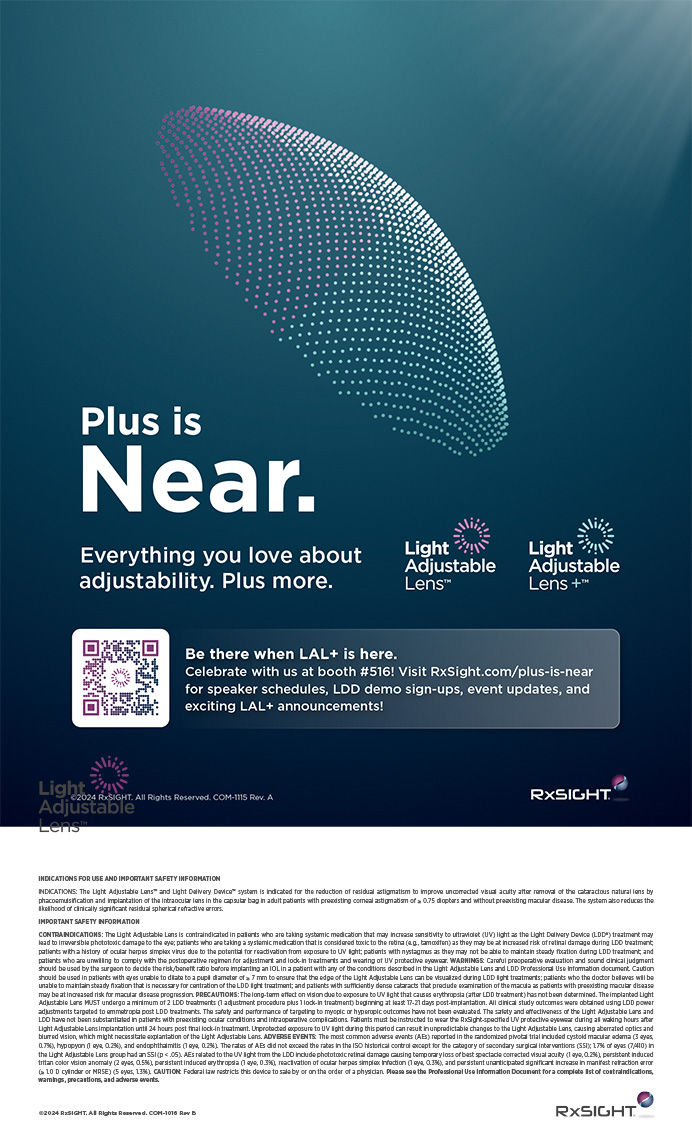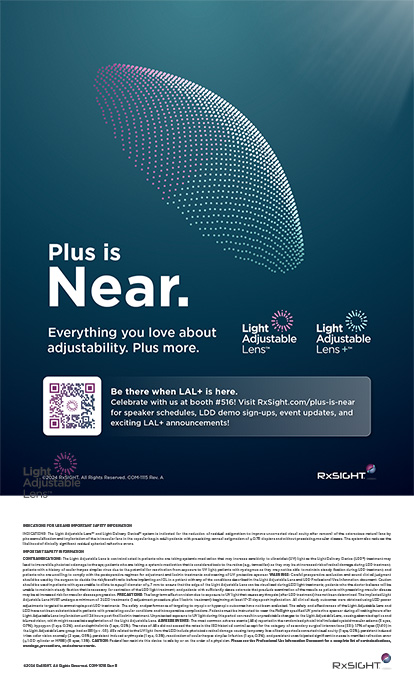In refractive surgery, the cornea will always remain the limiting factor for the correction of higher degrees of refractive error. The thickness, the keratometry, and the biomechanical properties of the cornea all have their influence on the final refractive outcome. It is of the utmost importance to avoid glare and halos by choosing large enough optical zones and respecting the mesopic pupil. In addition, to improve quality of vision, we must respect the characteristics of the cornea. For these reasons, bioptics is a powerful tool in the correction of high levels of ametropia. Combined phakic IOL (PIOL) implantation and LASIK allows the application of the maximal optical zones for both modalities.
I have been performing this combined technique for 4 years, and I have treated 159 eyes. One hundred thirty four eyes were myopic, between -8 and -26 D, and 25 eyes were hyperopic, between +4.5 and +12 D. In order to use the bioptic approach, the patients' preoperative anterior chamber depth must be at least 3.2 mm. I performed a YAG iridotomy (I usually prefer to perform two) on these patients at least 1 week before implanting the Artisan lens (OPHTEC, the Netherlands). I created the corneal flap with the Hansatome microkeratome (Bausch & Lomb Surgical, Claremont, CA). According to the patient's refractive error, corneal thickness, and mesopic pupil size, I chose either a 160- or 180-µm footplate with a flap diameter of 8.5 or 9.5 mm. I never used the combination of a 9.5 mm with the 160-µm microkeratome head due to the potential risk of creating a buttonhole or a pseudo-buttonhole.
LENS IMPLANTATION
I performed Artisan lens implantation using five drops of unpreserved oxybuprocaine while the patient was under topical anesthesia. Next, I injected 1 mL of lidocaine 1% intracamerally through the side port, and I administered a miosis-inducing substance in the same manner. Then, I injected a high viscosity viscoelastic (Healon GV; Pharmacia Corp., Peapack, NJ), and created a 5- or 6-mm clear corneal incision (this is done preferably on the steep axis). If the patient's astigmatism is substantial, I add a classic limbal-relaxing incision with a 600-µm depth.
I chose to implant a 6-mm optic Artisan lens to correct myopic eyes (Figure 1), and a 5-mm lens to correct hyperopic eyes. The postoperative refractive aim was set at a slight degree of myopia (-0.5 D). Myopic outcome after PIOL implantation is advantageous as it allows the correction of the combined residual myopic sphere and cylinder for the best result. The lens claws were fixated to the iris by the enclavation needle technique. The incision was closed with one or two 10–0 nylon stitches. Finally, I removed the Healon GV by flushing the anterior chamber through the side port, and checked the incision for leakage.
I examined the patients 1 day after surgery and then again 3 weeks later. If it was necessary, I removed the stitches at the 3-week postoperative visit. After another month, I checked the refraction and if required, scheduled a LASIK intervention. Next, I lifted the edge of the flap at the biomicroscope. I treated the residual refractive error using a Bausch & Lomb 217z laser (I always choose a maximal optical zone size). The hinge was protected during ablation and the postoperative regimen consisted of a mixture of gentamicin 0.3% with fluorometholone 0.1% four times per day for 3 days, and artificial tears with hyaluronic acid were administered at least four times daily for 1 month.
In my experience, patient safety was extremely satisfactory. One hundred forty eight eyes (93%) remained unchanged or gained one or more lines, and 122 eyes (77%) even gained two lines or more. One hundred fifteen eyes were myopic and 7 were hyperopic. There were only a few complications. One eye had mild iris bleeding with a hyphema of less than 1 mm after the YAG iridotomy.
COMPLICATIONS
Corneal erosions, including large and small abrasions, were the most commonly encountered complication during keratectomy, and occurred in 11% of the patients (17 eyes). Erosions smaller than 1 mm were not treated. The larger defects were covered with a bandage contact lens for 3 days, and in these cases, a stronger steroid was used for 1 week to avoid DLK. Flap striae were apparent in three eyes (2%) that I treated by relifting the flap and irrigating with a mixture of 50% sodium chloride 0.9% and 50% sterile water; the flap was stretched for at least 1 minute. With the Artisan IOL, pupil ovalization never occurred. The most difficult step of IOL surgery is the centration of the lens in relation to the pupil; in order to avoid problems with night driving, the lens has to be centered perfectly.
In six eyes (4%), glare and halos were more prominent than before surgery. No epithelial ingrowth or DLK occurred. One hyperopic eye was overcorrected by 2 D and needed an enhancement. One eye had pupillary block glaucoma due to insufficient removal of the high viscosity viscoelastic. After controlling the IOP, the pupil was fixed at 7.5 mm.
The combination of PIOL implantation followed by flap creation provides extremely satisfactory results in terms of efficacy, predictability, stability, and safety. The quality of vision is superior to the eyes treated with corneal laser surgery in higher ametropes (per my 1999 study comparing LASIK for myopia > -10 D and PIOL implantation for > -10 D). However, the patient must be extensively informed about the procedure, the potential risks, and the final outcome. Multiple interventions on the same eye can result in more complications. PIOL implantation can be complicated by endophthalmitis, which is clearly the most devastating complication. In addition, pupillary block glaucoma, pigmentary dispersion glaucoma, lens dislocation or decentration, lens opacities, and potential retinal problems can lower postoperative BSCVA. Concerns regarding long-term endothelial cell loss are still present.
FLAP MANAGEMENT
Most of the ocular problems after LASIK are due to flap complications. Flap handling is therefore very important and should always be carried out with great care. In the last year, my strategy toward bioptics changed. I now place the PIOL without creating a corneal flap first. I perform a keratectomy at least 6 weeks after IOL implantation (Figure 2). This time interval is important to allow for refractive stability and adequate healing of the clear corneal incision to prevent wound rupture during the keratectomy.
BENEFITS OF BIOPTICS
Because the keratectomy is performed at least 6 weeks after IOL implantation, the flap has to be manipulated only once and potential flap complications are minimized. No problems occurred and all corneal incisions could withstand the high IOP during flap creation. In nearly all cases, the bioptics procedure provides a gain in BSCVA and also very good optical quality. The refractive results are extremely predictable and efficient. The refractive outcome was stable after 2 months and follow-up out to 4 years did not show a more rapid decline in endothelial cell count except for the initial surgical trauma. Implantation of an Artisan PIOL respecting a minimal anterior chamber depth of 3.2 mm is safer for the endothelium, even in hyperopic eyes. Endothelial cell loss should be our biggest concern in the long run. The safety of the keratectomy after PIOL implantation needs to be further studied.
Better and more biocompatible PIOL materials and smaller incision sizes will further improve the outcome of the implantation. Our goal is to correct the refractive error in all cases with only one intervention. Toric PIOLs with sub–3-mm incisions can provide extremely good predictable results, even in patients who have high degrees of astigmatism. The quest for the perfect PIOL continues.
Erik Mertens, MD, is from the Antwerp Eye Center, Antwerp, Belgium. He does not hold a financial interest in any of the materials mentioned herein. Dr. Mertens may be reached at +32 3 828 29 49; e.mertens@skynet.be

